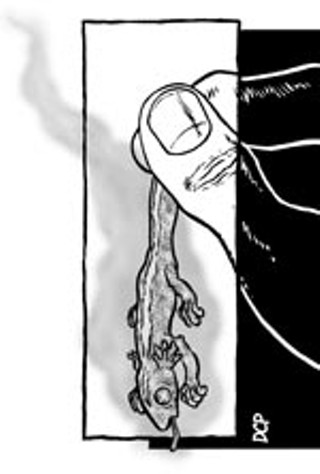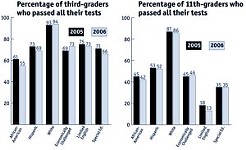FWS Punts Salamanders to TCEQ
Environmentalists decry shift in enforcement responsibility
By Rachel Proctor May, Fri., Feb. 11, 2005

If you've never seen a Barton Springs salamander in the flesh, you're not alone. It is, after all, endangered; it is also very small. Maxing out at three glorious inches of aquatic amphibian, it's easy to miss as it paddles around the cracks and fissures of the aquifer-fed springs it calls home.
The U.S. Fish and Wildlife Service, which handles enforcement of the Endangered Species Act, doesn't see many salamanders either. And that, says FWS Southwest region spokeswoman Elizabeth Slown, is a big problem with how ESA enforcement has typically been handled: The only time FWS can kick righteous butt on behalf of the salamander, or other endangered species, is when it can prove that "take" has occurred – industry jargon for members of the species being harmed.
"You have to come up with a dead salamander, so it's pretty hard to find the smoking gun," she said. Not only are smoking salamanders few – since the species was listed as endangered in 1997, FWS has not issued a single citation – Slown points out that a system that punishes violators is a bit backward if the goal is to keep members of the species alive. "We could only act if someone kills a bunch of endangered species," said Slown. "But what good does it do to cite them after the fact? The creature is already gone."
Moreover, most take occurs through habitat destruction – in the case of the salamander, that means water pollution, which is difficult to trace back to a single culprit. And even if you do find the cold-blooded, aquifer-pollutin' salamander-killer to slap with a $100,000 fine or a year in jail, much of the damage, in terms of roads, houses, or parking lots, is hard to reverse. This is why Austin's Save Our Springs ordinance, the city's effort to protect its salamander and its groundwater, regulates development to keep the Edwards Aquifer clean before anyone has a chance to throw down the kind of population density and impervious cover that bring water contamination to amphibian-choking, swimmer-annoying levels. But the SOS ordinance stops at the Austin city line, and out in the Hill Country, FWS has no power to do the same.
All of the above is the justification FWS gives for a new plan to change the way it protects endangered species in the Edwards Aquifer. Under the plan, which takes effect this month, FWS will still cite outright salamander destruction (provided it's apparent), but will pass primary species-protecting duties over to the Texas Commission on Environmental Quality. Not only will this system better protect the salamander and five other species, the agencies say, it will streamline the permit-application process for developers to boot. Here's how it will work: When developers get their groundwater quality permits that TCEQ has long required of development, they can also agree to undertake a second, optional set of measures to keep the water even cleaner.
And there was great rejoicing in salamander land …
Habitat Conservation Plans … No More
Well, not exactly. As would be expected, environmental groups are skeptical of, if not entirely hostile to, the plan. Many argue that, whatever its flaws, FWS was doing a pretty good job influencing development in the Hill Country, and warn that the optional measures don't go nearly far enough to protect the aquifer, for salamanders and humans alike.
"When you don't have enforcement, the solution is not to lower the standards," said environmental consultant Lauren Ross of Glenrose Engineering Inc. "That's not science. That's just political expediency." Ross argues that even if FWS technically can only act when take has occurred, the possibility of running afoul of the ESA does provide a deterrent that has effectively kept developers from paving willy-nilly over the Hill Country.
After all, the FWS argument is a little like saying, "We can only arrest criminals after the crime has already been committed, so why have laws at all?" No developer wants to dump millions of dollars into a project, only to find out he's squished a salamander or (more likely) muddied up the creek and now faces fines and legal complications up the wazoo. Thus, it has been common practice for Hill Country developers to work with environmental consultants to develop a Habitat Conservation Plan, which the FWS then approved, before calling in the bulldozers. The FWS couldn't force anyone to develop an HCP, but developers who did could rest assured that, so long as they followed their HCP, they were immune to penalties under the Endangered Species Act. It was like an insurance policy against the possibility that a smoking salamander might some day turn up on their property.
FWS "was making a difference in working with developers to make sure they meet these protective measures. I'm not saying the system was perfect, but it was certainly meaningful," said Nancy McClintock, a city of Austin watershed expert. "The problem is that as they're transferring over to TCEQ, those measures just aren't as stringent."
Specifically, the TCEQ measures don't include caps on impervious cover, which the FWS, as well as the SOS ordinance, have long held as a crucial component in protecting water quality. While the final rules for the optional measures have not yet been released, TCEQ and FWS have indicated that the measures will include setbacks from streams and sensitive features, and the use of structures such as containment ponds to reduce sedimentation and runoff. According to Robert Pine of the FWS Austin field office, these measures will be as effective as impervious cover limitations. "We're saying these are some things that will prevent take," he said. "That's not to say that there aren't other things that would also prevent take. But we believe these measures will be effective."
Enforcement … TBA
Impervious cover limitations have one major benefit: When developments are built in compliance with the limitations, the benefits are, essentially, permanent. Some of TCEQ's optional measures, such as buffer zones around streams, also have this benefit. But others, like structures designed to reduce sediment load, require ongoing maintenance to continue functioning – for example, ponds that trap sediment have to be cleaned out from time to time. And that means the TCEQ will have to monitor whether those structures are, in fact, being maintained, at a time when the agency is already strapped for resources, and is getting no new dollars or staff to handle the new program. This, says Ken Kramer of the Lone Star chapter of the Sierra Club, is a recipe for disaster. "I think there are many paths to the same goal," Kramer said, "but some of those paths require more management, more money, and more intensive monitoring and evaluation over time."
When Pine gave public presentations of the plan, he faced none-too-friendly skepticism from environmentalists. At one meeting in Oak Hill, an increasingly beleaguered-sounding Pine stressed that the whatever the flaws in the new system, the previous system had them, too. "FWS doesn't have many people," he said. "We can't go out and police the entire Edwards Aquifer. We just can't."
Pine emphasized again and again that people shouldn't see the TCEQ as the be-all, end-all of endangered species protection. The plan does not preclude other government entities, such as counties or municipalities, from implementing more stringent measures of their own, similar to Austin's SOS Ordinance. In fact, Pine encouraged those skeptical about the plan to work locally to come up with something stronger.
"We do hope other groups will implement local measures," he said. As they do so, they may want to refer to the FWS draft recovery plan for the Barton Springs salamander (ifw2es.fws.gov/Library), a collection of best management practices which FWS is currently updating as part of the salamander's five-year status review. Among other things, the 2005 draft continues to recommend impervious cover limitations and emphasizes the need for strong regional plans rather than a multitude of competing local ones. The public can submit comments on the recovery plan until March 28, but the new TCEQ rules are rolling out this month no matter what the public (and, apparently, some FWS scientists) think best.
Got something to say on the subject? Send a letter to the editor.








